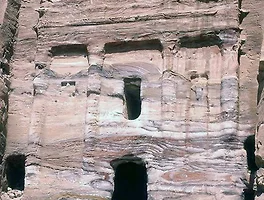










It was once thought that the theater was made after the Roman annexation of the Nabataean kingdom in AD 106, following their principle of providing food and entertainment to win favour with newly conquered peoples. 그것은 한때 극장 서기 106 년 Nabataean 왕국의 로마되었다 합병 후, 음식과 엔터테인먼트를 제공하는 그들의 원칙은 다음과 같은 부탁을 새로 사람을 정복과 승리를하는 것으로 생각되었다. But Dr Philip Hammond, the American archaeologist who excavated the theater in 1962-3, concluded that it was originally carved between 4 BC and AD 27, in the reign of Aretas IV, with some minor alterations by his successor, Malichus II, and some refurbishments when the Romans redeveloped the city. 하지만 박사는 필립 해먼드, 누가 1962-3 년에 극장에서 발굴된 미국인 고고학자, 그게 원래 4 기원전와 AD 27 일 사이 Aretas 4의 통치에 새겨진했다, 그의 후계자, Malichus II에, 그리고 일부 사소한 변경과 결론을 일부 refurbishments 때 로마인들이 도시를 redeveloped. This Roman activity could have been occasioned by an earthquake in AD 113/4. 이것은 로마의 활동이 서기 113 년에 지진에 의해 occasioned이었을 수도 / 4. Another earthquake on 19 May 363 doubtless caused more damage to the stage building than to the carved seating of the cavea; but the life of Petra – and probably of its theater – continued. 5월 19일 363 의심할 여지없이 cavea의 조각 좌석보다;하지만 페트라의 삶 -와 아마의 극장 - 지속적인 무대 건물에 더 많은 피해를 또 다시 지진이.
Though its design is Roman, according to the principles of Vitruvius, the floral capitals uncovered in the excavation are distinctively Nabataean. 비록 디자인 로마, Vitruvius의 원칙, 꽃 수도 발굴에서 명쾌하게 밝혀낸 Nabataean하는 일 보도했다. So too is the construction technique – a blend of confident mathematics and slogging, stone-chipping craftsmanship. 그러니 너무 건설 기술이다 - 자신 수학과 slogging, 석재 - 장인 지오바 니의 조화를 이룹니다. The scale of the theater is some measure of the size and prosperity of Petra in the first century AD. 극장의 규모의 크기와 페트라의 번영을 서기 1 세기의 일부를 측정합니다. In 1812 Burckhardt reckoned it would hold 3,000; 25 years later Comte Jules de Bertou accused him of exaggeration and suggested 1,200. 1812 Burckhardt에서는 3,000 기다려 주시겠어요 다지; 25 년간 저장 콩트 줄스 드 Bertou해도 과언이 그를 비난 1200 제안했다. A recent, carefully calculated estimate of a capacity audience puts it at around 5,000. 용량은 관객의 최근 신중하게 계산된 예상 주위에 5,000 놓는다.
그래서 급한 극장에서 그들이 어떤 무덤은 여전히 악의를 품고 밖으로 돌아 보곤 누구 벽에 얇게 남아 희생을 준비 Petrans에 대한 '열망했다. Perhaps the necropolis was the only area of the city with acceptable visibility (on the main street) where there was also sufficient space for so large and important an undertaking. 아마도 묘지 허용 횟수를 메인 스트리트 (한국 시간)와 함께 도시의 유일한 영역 그곳이 너무 크고 중요한 사업 또한 충분한 공간이었다. Maybe, too, the Nabataeans had no sense of incongruity in locating their entertainment in a graveyard. 아마도, 너무 Nabataeans 묘지에서 자신의 엔터테인먼트를 찾는데 부조화의 개념도했다. But such evident eccentricity provoked portentous or amused comment by most nineteenth-century travellers. 하지만 분명 기행 등 대부분 19 세기의 여행객에 의해 전조 또는 코멘트를 즐겁게 만들었다. 'Strange contrast!' '이상한 대비!' wrote the American theologian Edward Robinson in 1838, 'where a taste for the frivolities of the day, was at the same time gratified by the magnificence of tombs; amusement in a cemetery; a theater in the midst of sepulchres.' 1838 년, '어디 하루 중 상부에 대한 맛, 무덤의 웅대하여 같은 시간에 기쁘 있었던 미국의 신학자 에드워드 로빈슨이 쓴; 묘지에서 놀이; sepulchres의 중심부에있는 극장.
'여행지정보 > 요르단' 카테고리의 다른 글
| [요르단] 페트라 궁전무덤 (0) | 2009.09.06 |
|---|---|
| [요르단] 페트라 코린트의 무덤 (0) | 2009.09.06 |
| [요르단] 페트라 실크무덤 (0) | 2009.09.06 |
| [요르단] 항아리무덤 Urn Tomb (0) | 2009.09.06 |
| [요르단] 페트라 Street of Facades (0) | 2009.09.06 |
| [요르단] 페트라 시크 The Siq (0) | 2009.09.05 |
| [요르단] 페트라 오벨리스크 무덤 (0) | 2009.09.05 |
| [요르단] 페트라 Djinn Blocks (0) | 2009.09.05 |





